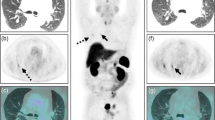Abstract
GH secreting pituitary adenomas are frequently visualized by scintigraphy with the somatostatin analogue 111Indium-pentetreotide. We studied 111Indium-pentetreotide scintigraphy and hormonal responses to octreotide in 12 acromegalic patients. Nine patients with active acromegaly were studied before pituitary adenomectomy; 6 of these and 3 other patients were studied after operation. GH was measured after a single sc dose of 100 µg of octreotide (acute test). The patients were preoperatively treated with 100 µg sc tid octreotide for 3 months as were patients who had been unsuccessfully operated; GH and IGF-I were measured at the end of this period (chronic treatment). A decrease of the hormones higher than 50% of basal values was considered a positive response in both acute test and chronic treatment. Eight/nine unoperated patients had a pituitary adenoma visualized by scintigraphy and a positive response to both the acute test and chronic treatment; one patient had no evidence of tumor at scintigraphy and he did not respond to octreotide. Scintigraphy was negative in all of the three patients cured by surgery. Six patients still had active disease after adenomectomy: scintigraphy was positive only in one case, although GH responded to octreotide treatment in all patients. Conclusions. 111In-pentetreotide scintigraphy frequently visualizes pituitary adenomas and predicts GH responses to octreotide in unoperated acromegalic patients. In unsuccessfully operated patients scintigraphy is infrequently positive and does not predict which patients will respond to octreotide. These data and the cost of 111In-pentetreotide scintigraphy do not warrant its extensive clinical use in acromegaly.
Similar content being viewed by others
References
Reubi J.C., Landolt A.M. High density of somatostatin receptors in pituitary tumours from acromegalic patients. J. Clin. Endocrinol. Metab. 59: 1148, 1984.
Krenning E.P., Kwekkeboom D.J., Bakker W.H., Breeman W.A.P., Kooij P.P.M., Oei H.Y, Van Hagen M., Postema P.T.E., De Jong M., Reubi J.C., Visser T.J., Reijs A.E.M, Hofland L.J., Köper J.W., Lamberts S.W.J. Somatostatin receptor scintigraphy with [111In-DTPA-d-Phe1]- and [123I-Tyr3]-octreotide: the Rotterdam experience with more than 1000 patients. Eur. J. Nucl. Med. 20: 716, 1993.
Ur E., Mather S.J., Bomanji J., Ellison D., Britton K.E., Grossman A.B., Wass J.A.H., Besser G.M. Pituitary imaging using a labelled somatostatin analogue in acromegaly. Clin. Endocrinol. (Oxf.) 36: 147, 1992.
Pierantoni M.C., Gasperi M., Molea N., Acerbi G., Burelli A., Lazzeri E., Tanda M.L., Brogioni S., Bianchi R. Use of 111In-Pentetreotide scan in the diagnosis and follow-up of pituitary adenomas. J. Endocrinol. Invest. 18(Suppl. to no. 5): 58, 1995.
Plöckinger U., Reichel M., Fett U., Saeger W., Quabbe H.J. Preoperative octreotide treatment of growth hormone-secreting and clinically nonfunctioning pituitary macroadenomas: effect on tumor volume and lack of correlation with immmunohistochemistry and somatostatin receptor scintigraphy. J. Clin. Endocrinol. Metab. 79: 1416, 1994.
Colao A., Ferone D., Lastoria S., Marzullo P., Cerbone G., Di Sarno A., Longobardi S., Merola B., Salvatore M., Lombardi G. Prediction of efficacy of octreotide therapy in patients with acromegaly. J. Clin. Endocrinol. Metab. 81: 235, 1996.
Lamberts S.W.J., de Herder W.W., Kwekkeboom D.J., vd Lely A.J., Nobels F.R.E., Krenning E.P. Current tools in the diagnosis of pituitary tumors. Acta Endocrinol. (Copenh.) 129(Suppl. 1): 6, 1993.
Janson E.T., Westlin J.E., Eriksson B., Ahlström H., Nilsson S., Öberg K. [111In-DTPA-D-Phe1] octreotide scintigraphy in patients with carcinoid tumours: the predictive value for somatostatin analogue treatment. Eur. J. Endocrinol. 131: 577, 1994.
Duet M., Mundler O., Ajzenberg C., Berolatti B., Chedin P., Duranteau L., Warnet A. Somatostatin receptor imaging in non functioning pituitary adenomas: value of an uptake index. Eur. J. Nucl. Med. 21: 647, 1994.
van Royen E.A., Verhoeff N.P.L.G., Meylaerts S.A.G., Miedema A.R. Indium-111-DTPA-octreotide uptake measured in normal and abnormal pituitary glands. J. Nucl. Med. 37: 1449, 1996.
Author information
Authors and Affiliations
Rights and permissions
About this article
Cite this article
Legovini, P., De Menis, E., Billeci, D. et al. 111Indium-pentetreotide pituitary scintigraphy and hormonal responses to octreotide in acromegalic patients. J Endocrinol Invest 20, 424–428 (1997). https://doi.org/10.1007/BF03347995
Accepted:
Published:
Issue Date:
DOI: https://doi.org/10.1007/BF03347995




